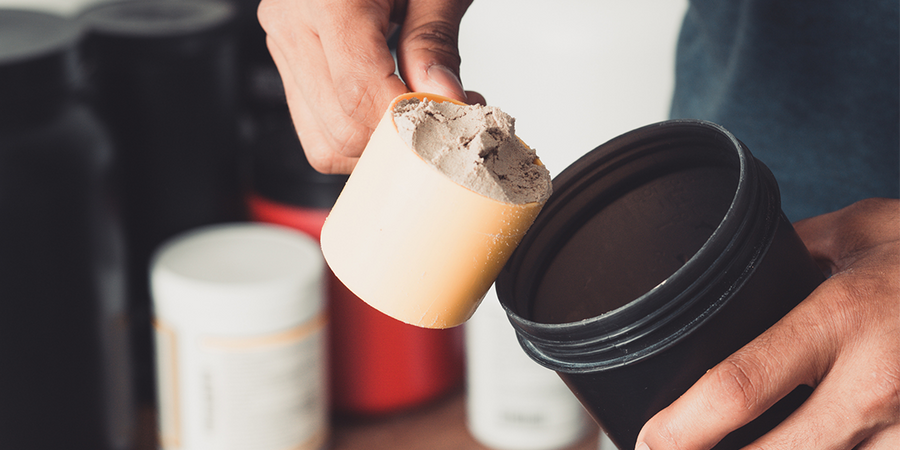
What "Recovery" Really Means — and What to Expect from Your Recovery Products
By Michael Martin
Working out is only part of the battle. To build muscle and realize your fitness goals, you need to make sure you're giving your muscles optimal time to recover. And time itself — while important — is just one factor in the equation.
There's a lot you can do during the recovery period to help your muscles rebuild and grow. To find out what happens during the muscle recovery process, and how to choose a "recovery" product, read on.
Recover, rebuild, and repair muscles more effectively with LADDER Whey or Plant Protein.
.
What Happens During the Muscle Recovery Process?
As complicated as our workouts may get, their effect on muscles is pretty basic. "During exercise, muscle damage and the tearing of muscle fibers are part of the process," says Paul Falcone, MS, NASM-CPT, CISSN, senior scientist at LADDER. "The body then adapts to that exercise stimulus by building the muscle back stronger."
.
How to Maximize Recovery
One of the key factors in recovery is simply time. You have to give your body time to replenish itself after an intense workout. But there are several science-backed ways you can give the process a boost.
1. Nutrition

"Making sure your body is provided with nutrients that aid in recovery is crucial to maximizing muscle recovery," says Josh Schlottman, a certified strength and conditioning specialist in Napa, California. Protein is key to muscle repair, but a balance of carbs and good fats are also important for building strength.
Whether you want to lose weight, gain muscle, or maintain your body composition, your sweet spot is a daily diet that's 40 percent carbs, 30 percent protein, and 30 percent fat. It's important to make sure you're getting enough of both carbs and protein, especially after a workout. Keep reading to find out why.
2. Light activity for active rest
"Light activity, often called active rest, is a great choice for your off days from hard training," says Rachel MacPherson, an ACE-certified CPT and pain-free performance specialist in Montreal. "Active rest such as hiking, swimming, walking, or other active hobbies will help increase blood flow and nutrients to the muscle tissues, speeding healing."
3. Sleep more and stress less

Sleep is crucial for muscle recovery — it's the time when the body heals and rebuilds itself. "Without proper sleep, the hormonal signals and energy you need to build muscle or gain strength can not be fully realized," says MacPherson. Aim for seven or more hours of quality sleep every night.
Managing stress is also important. "Lowering your stress levels will help to maximize your recovery," says Schlottman. "Stress hormones like cortisol can cause muscle tension, lower blood flow and increase lactic acid, all of which can reduce muscle growth and elasticity."
4. Foam rolling
You may also want to use massage or foam rolling to help muscles recover faster. Foam rolling may reduce muscle tension and increase blood flow, which can help muscle fatigue and soreness. Several studies — including one published in the Journal of Athletic Performance in 2015 — have found that using a foam roller effectively reduced delayed-onset muscle soreness (DOMS) and boosted muscle recovery.
5. Compression wear

Some people also find compression wear effective for expediting recovery: It may reduce inflammation that occurs post-workout by moving waste out of muscles faster, helping muscles recover and rebuild more quickly with less soreness.
.
Types of Recovery Workouts
While you need to give your muscles time to rest and recover, that doesn't mean you have to sit on the couch between workouts. Active recovery can be a powerful tool in efficient muscle recovery. This may include low-impact activities like:
- Light cardio, like walking or jogging
- Yoga
- Swimming
- Cycling
- Active stretching
The National Academy of Sports Medicine advises keeping your heart rate at 30 to 60 percent of your maximum rate while doing active recovery. You can also add active recovery to the end of a heavier workout.
.
How to Eat for Muscle Recovery
We could all use an edge in building muscle, but as far as nutrition is concerned, there's no complicated code to crack. "The best way to eat for muscle recovery is to ensure you consume plenty of protein and carbohydrates along with enough calories to support your training and additional calories if you are trying to put on muscle mass," says MacPherson. It's ideal to consume carbohydrates along with protein after a workout.
Both protein and carbs are crucial in the recovery process. Protein contains amino acids, the building blocks of muscle. Carbs help to replace your muscles' depleted stores of glycogen, which aids in recovery.
Nutrients including omega-3 fatty acids and vitamin C have also been found to help the recovery process, says MacPherson.
You may also want to consider a protein supplement or supplement specifically geared toward recovery.
.
What to Look for in a Muscle Recovery Product

"Basically, we look at three main measurements for a supplement if it's going to help with recovery," says Falcone. They are:
1. It Should Reduce Soreness.
DOMS "is different from the burn you feel during exercise," says Falcone. It tends to happen the day after a workout and may peak two days later, depending on how intensely you've exercised.
"If a product is going to help me recover, it should reduce my feelings of soreness over time," says Falcone. That benchmark is measured and clinically studied. When it comes to DOMS, an effective recovery product will induce effects over a 24-, 48-, and 72-hour period, he explains.
2. It Should Increase Post-Workout Strength.
Post-workout soreness and strength tend to go hand-in-hand. "If you have exercised so intensely that you're sore, that will often be accompanied by reduced function," says Falcone. "The next day, you're unable to exercise that muscle to the same degree at 100%."
Scientists can pinpoint how long it takes for muscle function to return. "An ideal recovery product would help return that muscle function, so you could then go out and perform in the following days with a faster return to 100 percent muscle function," he adds.
3. It Should Improve Certain Biomarkers.
A range of biomarkers can measure the muscle damage that occurs during exercise and how quickly (or slowly) it's repaired during exercise. "When the muscle fibers tear apart, there are certain molecules inside the muscle that leak outside into the bloodstream," says Falcone. "They're good indicators for muscle damage, because they're generally in really low amounts in the bloodstream. We often look at those biomarkers to see if there's a reduction in muscle damage."
An effective recovery product will yield improvements in all three — strength, soreness, and biomarkers of muscle damage. One such ingredient used in LADDER supplements is tart cherry. "That is added to our whey protein and plant proteins precisely for recovery," says Falcone. "These supplements are formulated to be post-workout recovery beverages. Protein provides the building blocks for muscle rebuilding, and tart cherry is there for the recovery aspect."
So, before you buy another recovery product, make sure it's hitting all three of those targets to help you bounce back after your workouts.



